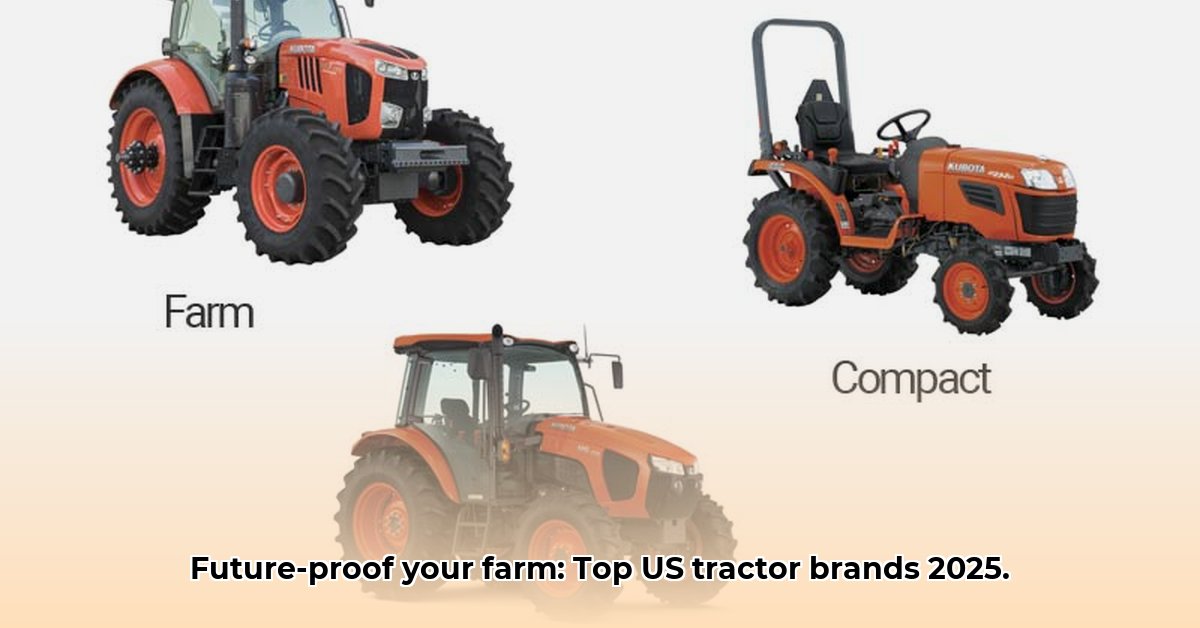
Different Brands of Tractors: Your Guide to Sustainable Farming in 2025
Choosing the right tractor is a significant investment for any farmer. This guide helps you navigate the options, focusing on sustainability and long-term value. We'll examine leading US brands, considering factors beyond initial purchase price to inform your decision. Factors like fuel efficiency, maintenance costs, and resale value will be considered. The complexities of truly measuring a tractor's overall environmental impact are also discussed. For more information on US-made tractors, check out this helpful resource: US Tractor Brands.
The Major Players: John Deere, Case IH, and New Holland
These are established brands, known for powerful machines and extensive dealer networks. This readily available support ensures easier access to parts and repairs, minimizing downtime. However, the total environmental cost of a tractor extends far beyond simple fuel consumption. It encompasses manufacturing processes, materials used, lifespan, and eventual disposal. Complete transparency on these factors is crucial for informed decision-making, though readily available data remains limited. These companies are increasingly incorporating fuel-efficient engines and precision farming technologies to reduce resource use, but more comprehensive lifecycle assessments are needed.
Smaller but Competitive: Kubota, Mahindra, and Kioti
These brands often provide a more affordable entry point, particularly attractive to smaller farms or those with tighter budgets. Their compact size excels in maneuverability, potentially reducing fuel consumption in smaller fields. However, farmers must carefully assess whether these smaller machines provide sufficient power for their specific needs. Balancing fuel savings against potential increases in labor costs is vital. The long-term sustainability factors, like those noted for the larger brands, must still be carefully considered.
Sustainability: A Holistic View
True sustainability extends beyond fuel efficiency. It encompasses the entire lifecycle of the tractor, from raw material sourcing to manufacturing, operational use, maintenance, and eventual disposal. The industry is progressing in areas like:
- Fuel Efficiency: New engines continuously improve fuel economy.
- Precision Farming: Technologies like GPS guidance and automated steering minimize resource waste, enhancing both sustainability and profitability.
- Operator Comfort: Ergonomics improve operator well-being, leading to increased productivity and reduced operator fatigue, contributing positively to sustainability metrics.
However, comprehensive, standardized data comparing the total lifecycle sustainability of different brands is currently lacking. Independent, third-party studies are needed to move beyond manufacturer claims.
How to Compare Lifecycle Costs of Sustainable American Tractor Brands
Key Takeaways:
- The American tractor market is dominated by established brands, but smaller manufacturers offer viable, specialized alternatives.
- Technological advancements in precision agriculture significantly impact both efficiency and sustainability.
- Assessing the true sustainability of tractor brands requires comprehensive lifecycle cost analysis, which current data often lacks.
- Farmers should carefully consider their specific needs and operational requirements when selecting a tractor.
Assessing Lifecycle Costs: A Step-by-Step Approach
Effective comparison of lifecycle costs requires a systematic approach. While complete data on long-term sustainability may be elusive, focusing on key factors enables informed decision-making:
- Define Operational Needs: Carefully assess farm size, terrain, and specific tasks.
- Research and Shortlist: Identify potential brands and models based on your needs and budget.
- Analyze Initial Costs: Compare the purchase price of different tractors.
- Estimate Fuel Consumption: Obtain and compare data on fuel efficiency per hour of operation. How much fuel will this tractor use over its lifespan?
- Project Maintenance Costs: Research typical maintenance and repair expenses for each brand and model. What are the potential maintenance costs over five years?
- Assess Resale Value: Estimate potential resale values after a set timeframe. Will this tractor still hold its value after five years? How does it compare to competitors?
- Calculate Total Lifecycle Costs: Sum up all costs (initial purchase, fuel, maintenance) and subtract the projected resale value. This provides a clearer picture of the true cost of ownership.
This methodology provides a framework for assessing costs and sustainability, but it's crucial to acknowledge that complete and precise data, especially on long-term environmental impact, remains limited. Further research and transparency from manufacturers are needed for a complete picture. The right tractor is a significant investment, and thorough evaluation of lifecycle costs is essential for long-term farm success and sustainability.